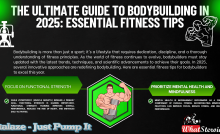How To Get Stronger Without Additional Mass Gains
Not few are those who look for ways to increase body strength without bulking at all. It may seem strange, but there can be many reasons for this. Whether you decide that you packed on enough muscle mass and go to the next round of getting stronger, or simply put you are in a type of sport where being too big is detrimental to your performance. Powerlifting is the kind of sport where body strength indicator plays the biggest role, but it is not limited to it. Bodybuilders need to get stronger too from the simply strength precedes muscle gains.
The stronger you are, the more weights you lift, hence more muscles are built. If you decided to get stronger, then there is a list of training and diet factors to be considered. Training for muscle mass and that for strength are two different things, that’s why a careful approach is needed in order to make your aim of gaining more power a reality. Further, in this article, you will find the core of a successful strength training program so that to get to the destination with totally satisfied with your achievements.
Decrease the Number of Reps


A higher number of reps (8-12 per set) is characteristic for bulking goal. If you really intend to build strength, then you should lower reps to five per set. To get stronger you need to lift less, but using the heaviest weights. Therefore, instead of working with easy weights and being able to do 12 reps in a raw, switch to lifting weights as heavy as possible in quite lower range, maximum 5 reps.
Building strength is much more about the amount of weight you lift, then in what number you do it. Simply taken, lifting heavy weights will not allow you to go with many reps, so that you stick to fewer even if you don’t want it.
Must Read: How Many Sets for Each Exercise?
Adjust Diet to the New Goal


Calorie intake is the second thing to consider when it comes to building strength. Even you don’t see the difference very clearly; following the same eating habits is not going to help you get stronger. First of all, reduce calorie intake to a level which sustains strength gains. High food intake supplies the body with enough nutrients to cause more muscle gains, which is not needed when looking to build strength.
Must Read: Dietary for Newbie Bodybuilders
Therefore, fewer calories provide the body with the energy and nutrients needed for working out and well being, without turning them into more muscles. How much to reduce calorie intake? A very good question, as going below the level you need to maintain your body weight may get you into troubles. There is not an equal sign between dieting for strength and that for getting lean.
Must Read: How Many Calories A Day To Eat To Build Muscle?
When looking to get stronger, you still need enough calories to maintain the weight you have and, more important, to be able to train harder next time you go to the gym. In these circumstances, you need a maintenance calorie intake and even you notice some gains in muscle mass. They would be beneficial during recovery time. The most important is that these gains don’t go above the normal limits. This means that you are more bulking then getting stronger.
Less Cardio Workout for more Strength Gains
Too much cardio training can be detrimental to building strength. Take a look at a marathoner and observe how lean they are and don’t think that body strength indicator is high. There are many bodybuilders who consider cardio training not useful at all for getting stronger. Is not like this, as short cardio training (20-30 minutes) performed twice a week is gonna help with burning calories. Also, increasing body strength with better oxygenating muscles when working out.
You need a wise combination of cardio training with lifting weights to register the noticeable increase in strength in a short time. As mentioned earlier, a high reps training volume (8-10 reps for each set) is going to promote muscle size increase, rather than strength gains. That’s why going with lower rep training is going to benefit your body in a better way.
Must Read: The Do’s And Don’ts Of Low And High-Intensity Cardio
Olympic Lifts for Great Gains in Strength
Among the many of techniques claim to big strength gains, Olympic lifts workouts proved to be the most effective. Clean and jerk, the hang clean and the overhead snatch are the most important Olympic lifts for maximum strength gains. With such an arsenal of movements, your training would be more helpful than any cardio and low rep volume training took together.
The big problem with Olympic lifts is that not everyone is entitled to use them for gaining strength. They are more suitable for experienced bodybuilders. While novice ones are advised to learn basic exercises and then switch to these ones. There are two reasons for this: you need to learn the proper technique execution of compound exercises and second, gradually prepare your body for heavyweights. A weak body will most probably end up with injuries that surely nobody wants.
If you want to build muscle and strength simultaneously, check our post "How to gain muscle size and strength fast" to find out how you can do it. The biggest requirement for building strength is: consistency. No training program, no wonder diet will work if you are not persevering in what you do. Make a plan, write it down and stick to it! No excuses for missing gym or get over training. Only consistent work in the gym is going to lead within months to reaching your strength limits.
Recent Posts
Creatine vs Myostatin: An Expert’s Analysis
Myostatin, a protein encoded by the MSTN gene, acts as a regulator of muscle growth.…
Raloxifene (Evista) 101: A Non-Surgical Solution for Gyno
Raloxifene, a selective estrogen receptor modulator (SERM), is one of the most valuable yet less…
Mastering Bodybuilding in 2025: Top Fitness Tips for Success
Bodybuilding is more than just a sport; it's a lifestyle that requires dedication, discipline, and…
Why Post-Cycle Therapy (PCT) Fails After a Nandrolone Cycle
Nandrolone, or Deca Durabolin, is an injectable anabolic steroid often used by bodybuilders during the…
Counteracting Anabolic Resistance with Adaptogens in Aging Men
As people age, maintaining muscle mass and strength becomes increasingly challenging due to a natural…
Tips on How to Store Peptides and HGH
When peptides are mixed with bacteriostatic water (BAC water), their longevity is highly influenced by…



